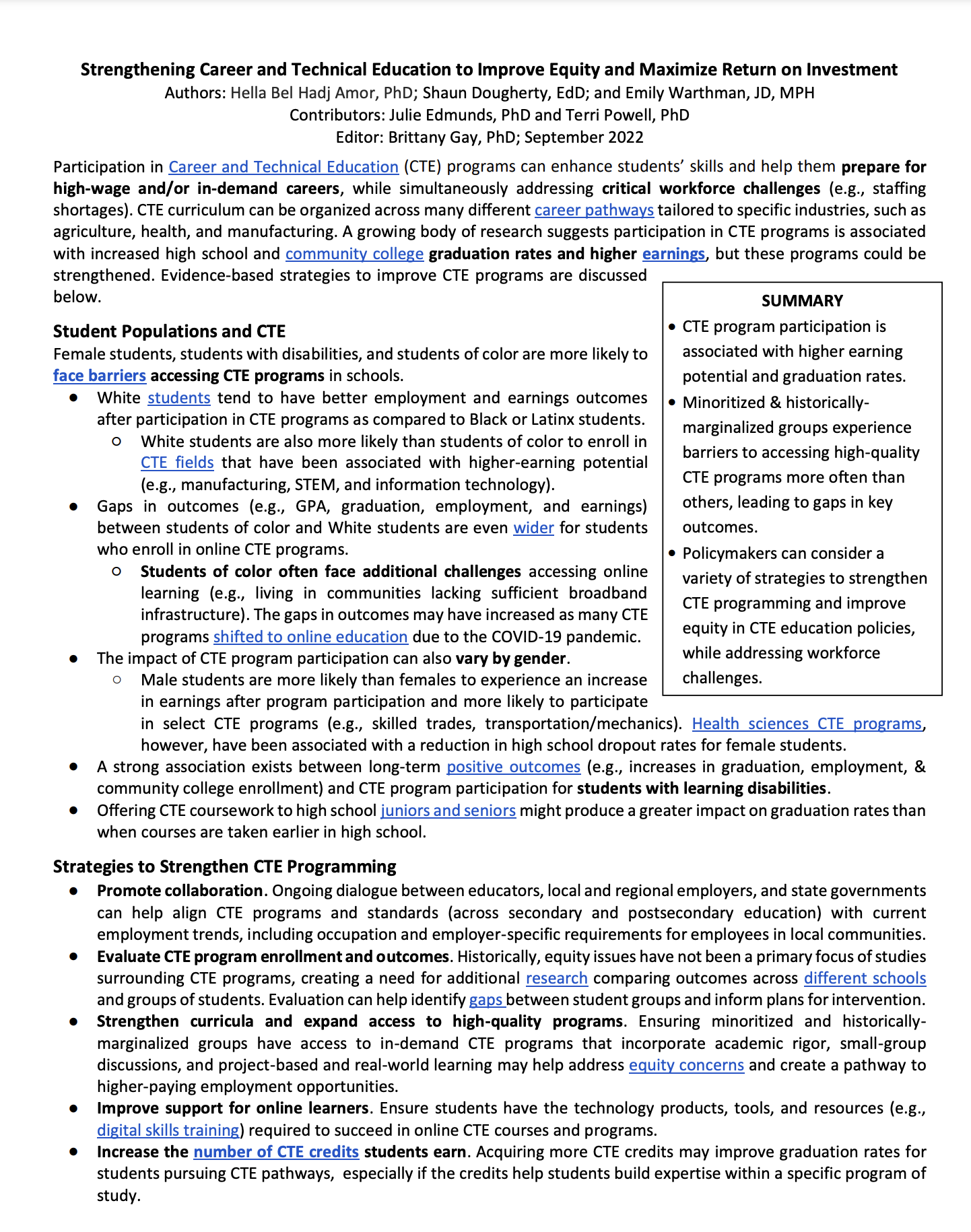
Participation in Career and Technical Education (CTE) programs can enhance students’ skills and help them prepare for high-wage and/or in-demand careers, while simultaneously addressing critical workforce challenges (e.g., staffing shortages). CTE curriculum can be organized across many different career pathways tailored to specific industries, such as agriculture, health, and manufacturing. A growing body of research suggests participation in CTE programs is associated with increased high school and community college graduation rates and higher earnings, but these programs could be strengthened. Evidence-based strategies to improve CTE programs are discussed below.
Summary
- CTE program participation is associated with higher earning potential and graduation rates.
- Minoritized & historically-marginalized groups experience barriers to accessing high-quality CTE programs more often than others, leading to gaps in key outcomes.
- Policymakers can consider a variety of strategies to strengthen CTE programming and improve equity in CTE education policies, while addressing workforce challenges.
Student Populations And CTE
Female students, students with disabilities, and students of color are more likely to face barriers accessing CTE programs in schools.
- White students tend to have better employment and earnings outcomes after participation in CTE programs as compared to Black or Latinx students.
- White students are also more likely than students of color to enroll in CTE fields that have been associated with higher-earning potential (e.g., manufacturing, STEM, and information technology).
- Gaps in outcomes (e.g., GPA, graduation, employment, and earnings) between students of color and White students are even wider for students who enroll in online CTE programs.
- Students of color often face additional challenges accessing online learning (e.g., living in communities lacking sufficient broadband infrastructure). The gaps in outcomes may have increased as many CTE programs shifted to online education due to the COVID-19 pandemic.
- The impact of CTE program participation can also vary by gender.
- Male students are more likely than females to experience an increase in earnings after program participation and more likely to participate in select CTE programs (e.g., skilled trades, transportation/mechanics). Health sciences CTE programs, however, have been associated with a reduction in high school dropout rates for female students.
- A strong association exists between long-term positive outcomes (e.g., increases in graduation, employment, & community college enrollment) and CTE program participation for students with learning disabilities.
- Offering CTE coursework to high school juniors and seniors might produce a greater impact on graduation rates than when courses are taken earlier in high school.
Strategies To Strengthen CTE Programming
- Promote collaboration. Ongoing dialogue between educators, local and regional employers, and state governments can help align CTE programs and standards (across secondary and postsecondary education) with current employment trends, including occupation and employer-specific requirements for employees in local communities.
- Evaluate CTE program enrollment and outcomes. Historically, equity issues have not been a primary focus of studies surrounding CTE programs, creating a need for additional research comparing outcomes across different schools and groups of students. Evaluation can help identify gaps between student groups and inform plans for intervention.
- Strengthen curricula and expand access to high-quality programs. Ensuring minoritized and historically-marginalized groups have access to in-demand CTE programs that incorporate academic rigor, small-group discussions, and project-based and real-world learning may help address equity concerns and create a pathway to higher-paying employment opportunities.
- Improve support for online learners. Ensure students have the technology products, tools, and resources (e.g., digital skills training) required to succeed in online CTE courses and programs.
- Increase the number of CTE credits students earn. Acquiring more CTE credits may improve graduation rates for students pursuing CTE pathways, especially if the credits help students build expertise within a specific program of study.
The Research-to-Policy Collaboration (RPC) works to bring together research professionals and public officials to support evidence-based policy. Please visit their website to learn more.
Key Information
RPC Website
Research-to-Policy Collaboration
Publication DateSeptember 1, 2022
Topic Area(s)Education and Child Development, Equity, Economy and Entrepreneurship
Resource TypeWritten Briefs
Share This Page
Participation in Career and Technical Education (CTE) programs can enhance students’ skills and help them prepare for high-wage and/or in-demand careers, while simultaneously addressing critical workforce challenges (e.g., staffing shortages). CTE curriculum can be organized across many different career pathways tailored to specific industries, such as agriculture, health, and manufacturing. A growing body of research suggests participation in CTE programs is associated with increased high school and community college graduation rates and higher earnings, but these programs could be strengthened. Evidence-based strategies to improve CTE programs are discussed below.
Summary
- CTE program participation is associated with higher earning potential and graduation rates.
- Minoritized & historically-marginalized groups experience barriers to accessing high-quality CTE programs more often than others, leading to gaps in key outcomes.
- Policymakers can consider a variety of strategies to strengthen CTE programming and improve equity in CTE education policies, while addressing workforce challenges.
Student Populations And CTE
Female students, students with disabilities, and students of color are more likely to face barriers accessing CTE programs in schools.
- White students tend to have better employment and earnings outcomes after participation in CTE programs as compared to Black or Latinx students.
- White students are also more likely than students of color to enroll in CTE fields that have been associated with higher-earning potential (e.g., manufacturing, STEM, and information technology).
- Gaps in outcomes (e.g., GPA, graduation, employment, and earnings) between students of color and White students are even wider for students who enroll in online CTE programs.
- Students of color often face additional challenges accessing online learning (e.g., living in communities lacking sufficient broadband infrastructure). The gaps in outcomes may have increased as many CTE programs shifted to online education due to the COVID-19 pandemic.
- The impact of CTE program participation can also vary by gender.
- Male students are more likely than females to experience an increase in earnings after program participation and more likely to participate in select CTE programs (e.g., skilled trades, transportation/mechanics). Health sciences CTE programs, however, have been associated with a reduction in high school dropout rates for female students.
- A strong association exists between long-term positive outcomes (e.g., increases in graduation, employment, & community college enrollment) and CTE program participation for students with learning disabilities.
- Offering CTE coursework to high school juniors and seniors might produce a greater impact on graduation rates than when courses are taken earlier in high school.
Strategies To Strengthen CTE Programming
- Promote collaboration. Ongoing dialogue between educators, local and regional employers, and state governments can help align CTE programs and standards (across secondary and postsecondary education) with current employment trends, including occupation and employer-specific requirements for employees in local communities.
- Evaluate CTE program enrollment and outcomes. Historically, equity issues have not been a primary focus of studies surrounding CTE programs, creating a need for additional research comparing outcomes across different schools and groups of students. Evaluation can help identify gaps between student groups and inform plans for intervention.
- Strengthen curricula and expand access to high-quality programs. Ensuring minoritized and historically-marginalized groups have access to in-demand CTE programs that incorporate academic rigor, small-group discussions, and project-based and real-world learning may help address equity concerns and create a pathway to higher-paying employment opportunities.
- Improve support for online learners. Ensure students have the technology products, tools, and resources (e.g., digital skills training) required to succeed in online CTE courses and programs.
- Increase the number of CTE credits students earn. Acquiring more CTE credits may improve graduation rates for students pursuing CTE pathways, especially if the credits help students build expertise within a specific program of study.
The Research-to-Policy Collaboration (RPC) works to bring together research professionals and public officials to support evidence-based policy. Please visit their website to learn more.

Key Information
RPC Website
Research-to-Policy Collaboration
Publication DateSeptember 1, 2022
Topic Area(s)Education and Child Development, Equity, Economy and Entrepreneurship
Resource TypeWritten Briefs
Share This Page
LET’S STAY IN TOUCH
Join the Evidence-to-Impact Mailing List
Keep up to date with the latest resources, events, and news from the EIC.




